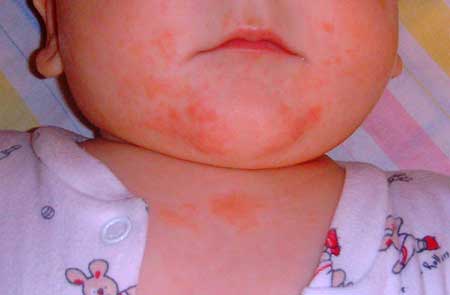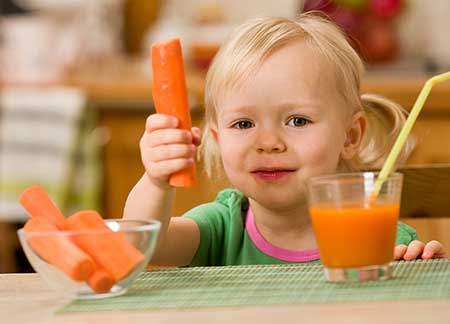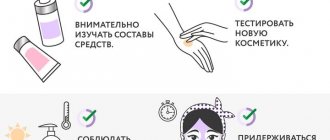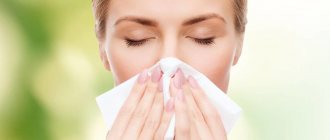Can you be allergic to juice?
Allergies can occur to almost any food product, including those classified as low allergenic.
Therefore, the appearance of signs of intolerance to drinking any juice is not uncommon.
The main allergens that provoke the development of a specific immune reaction when drinking juices are:
- Beta-carotenes are substances found in many fresh vegetables and fruits;
- Chemical components added to drinks at the stage of industrial production;
- Fertilizers used in the process of growing plant products;
- Molds that remain on fresh fruits and vegetables when they are not sufficiently processed.
If an allergy develops to freshly squeezed juices, then it should be considered as a true allergic reaction.
Whereas the appearance of intolerance to store-bought drinks indicates a possible allergy to acids, flavorings, that is, to additional additives. It happens that an allergic reaction occurs only when consuming a product from a certain manufacturer, which definitely leads to the assumption that it contains additional ingredients.
The development of an allergy to juice in young children is also associated with imperfections in the digestive system. The child’s intestines do not yet have a sufficient amount of enzymes responsible for the complete processing and digestibility of food entering the stomach.
Therefore, the load on the gastrointestinal tract in the form of concentrated liquid can cause the development of intolerance symptoms.
Often, intolerance to juices in children is caused by their incorrect administration. The baby's body needs to gradually increase the dose of any new product.
The introduction of juices begins with a few drops; you need to prepare them yourself from vegetables and fruits of the highest quality.

Modern pediatricians believe that the early introduction of freshly squeezed juices can be postponed until a later date, since children’s stomachs are not always able to fully digest the concentrated drink.
General information
Can children be allergic to apples?
Allergy is a high level of sensitivity to various substances (allergens), upon contact with which the immune system triggers the production of specific antibodies that provoke the occurrence of allergic symptoms.
Various components that make up food products often act as allergens: fruits, vegetables, meat, fish, berries, cereals.
Most often, food allergies are diagnosed at an early age, when the child is not yet three or four years old.
The degree of allergenicity of apples is uneven and depends on the variety, level of ripeness and cooking method:
- Fresh apples are the most allergenic because they contain the highest concentration of substances that cause an allergic reaction.
- Allergenic components of apples that have been subjected to heat treatment cause an allergic reaction less often, but can still cause symptoms characteristic of allergies.
- If a child has a severe allergy, its symptoms will appear upon contact with an allergen in any form , even if the product contains a tiny amount of it, so it is important for parents of an allergic child to carefully read the ingredients and not buy products that contain apple components.
- If apples are added to a cosmetic product , interaction with it can also cause an allergic reaction.
- The redder and brighter the apple, the more allergenic substances it contains, so some children are allergic only to red apples, but not to yellow or green ones. Green apples are considered hypoallergenic, but it is important to remember that a substance with even a minute degree of allergenicity can cause an allergic reaction.
- An allergic reaction to apple juices, baby food with apples, dried fruits, jam, compote can also occur, but is usually expressed more mildly than when eating a fresh apple. If your child has a mild apple allergy, he or she can usually eat apple products in moderation.
- Unripe apples are less allergenic than ripe ones.
Allergies to apples are less common than to some other common fruits and vegetables, such as oranges, tangerines, carrots, peaches, and kiwis, but are also not uncommon, especially in young children with compromised immune systems.
A significant proportion of children who have allergic reactions do not have hypersensitivity to some components, and the symptoms arose due to age-related characteristics of the gastrointestinal tract: in young children it is underdeveloped, and much less enzymes that break down products are produced than in adults , so if a child eats too many apples at once, he may have an allergic reaction.
If a breastfed baby suddenly shows signs of an allergy, it is important for the mother to review her diet and understand what could be causing it.
A baby with an allergy to apples who drinks milk from a mother who ate them the day before will show signs of an allergic reaction.
Allergy to apple juice
Traditionally, several years ago, the introduction of juices began with apple juice. But children are increasingly developing allergies to this product.
The reason for its appearance is the various acids present in fresh fruit.

In most people, disturbances in the functioning of the immune system are provoked by the consumption of red apples or their juice. The culprits in this case are coloring pigments.
Apple juice intolerance in children manifests itself with the following symptoms:
- Rash and redness on the body. You can notice pink spots on the cheeks, often the buttocks turn red and peel;
- The appearance of the rash is accompanied by itching;
- Increasing colic, regurgitation;
- Liquefied stool.

The severity of symptoms of intolerance to fresh apple juice can vary, ranging from minor changes in well-being to Quincke's edema.
A relationship was found between the amount of drink consumed and the intensity of the allergic reaction. That is, the more a child drinks a freshly squeezed or store-bought product, the higher his risk of developing severe symptoms of the disease.
For orange juice for a child
Citrus fruits are among the most allergenic fruits. A reaction to their use occurs not only in children, but also in adults, so orange juice should be introduced into the diet as late as possible.
The reason for the body’s specific reaction when consuming oranges and products made from them is explained by:
- Insufficient amount of enzymes in the child’s body, which cannot fully cope with the digestion of exotic fruit;
- Hereditary predisposition;
- Helminthiasis. Children are susceptible to infection by various parasites that disrupt the functioning of the immune system and pollute the body. This leads to an unusual reaction of the body to fruits, vegetables and other foods.
Allergy to orange juice occurs:
- Changes in the skin - rash, itching, atopic dermatitis;
- Rhinitis, swelling of the mucous membranes of the oropharynx and lips. In severe cases, bronchospasm develops, manifested by suffocation, coughing, wheezing;
- Dizziness;
- Swelling of the eyes, lacrimation.
POPULAR WITH READERS: Vasomotor rhinitis symptoms, causes, treatment
In young children, intolerance to orange drink sometimes manifests itself as a serious illness - enterocolitis. The child develops abdominal pain, severe colic, nausea, and diarrhea.
All this quickly leads to dehydration, so in this condition, medical care should be provided to the baby as early as possible.
If you give citrus fruits to infants, they may develop diathesis on the cheeks, and there is also irritation of the skin near the mouth, where a large amount of fruit acids enters.
Reasons for appearance
The mechanism of allergic reactions has not been studied enough, but there are factors that increase the risk of allergy and pseudo-allergy to apples:
- Predisposition to allergic reactions, inherited. If the mother or father of a child is allergic to apples, the likelihood that their offspring will have it is 30-50%, and if both have it, then 60-80%.
- Artificial feeding. Children who have been fed breast milk for quite a long time (at least six months, and ideally at least a year) are less likely to get sick, and they are also less likely to develop allergies. Therefore, without compelling reasons, you should not transfer a child who is under six months old to artificial nutrition.
- Wrong approach to complementary feeding. New foods should be given to the child in very small quantities, mixed with familiar ones, so that his body is able to digest them, and the quantity should be gradually increased. It is better not to use raw apples for complementary feeding: the gastrointestinal tract of a small child is not always able to digest them well enough.
Read about the symptoms of watermelon allergy in children here.
For carrot juice for a child
Carrots are one of the most allergenic vegetables, and their juice is even more likely to cause allergies.
The main reason for the body's specific reaction when eating carrots is beta-carotene, which is contained in the largest amount in this orange vegetable.

The reason for changes in well-being are also the chemicals used when fertilizing the grown carrots or during processing during the harvesting of the vegetable.
If a child is allergic to carrot juice, gastrointestinal disorders occur - abdominal pain, bloating, nausea, diarrhea.
Skin signs of intolerance include red spots on the body, rashes of various shapes, irritation and itching. Swelling of the mucous membranes of the nasopharynx and oropharynx often appears.
Less commonly, intolerance to carrot juice is manifested by respiratory symptoms - sneezing, coughing, shortness of breath.
Diagnostics
During the diagnostic process, it is important for attending physicians to distinguish allergies from infectious diseases (chickenpox, acute respiratory infections and others) and understand what substance causes the reaction.
The following diagnostic measures :
- analysis showing the content of immunoglobulin E;
- prick tests or scratch tests;
- provocative tests;
- elimination tests;
- examination of the child's stool;
- clinical blood test.
Doctors can also give directions for other tests, depending on the child’s condition.
For tomato juice for a child
Tomato juice contains allergenic substances such as lycopene and anthocyanin; it is to these that some people develop antibodies.
Tomato intolerance in children can be caused by consuming large quantities of this vegetable or products based on it at once.
Tomatoes are quite heavy vegetables for the digestive system, requiring the use of a large group of enzymes during the digestion process.
You can suspect an allergic reaction to tomato juice based on the following changes:
- Skin rashes. Intolerance to tomatoes leads to the appearance of pinpoint rashes and blisters on the neck, chest, abdomen, flexor surfaces of the elbow joints, and face. Damage to other parts of the body cannot be ruled out;
- Dryness of certain areas of the skin;
- Itching. Moreover, itching can also occur where there are no skin changes;
- Abdominal pain, diarrhea, nausea;
- Sneezing, runny nose, shortness of breath, conjunctivitis.

The reaction to tomatoes also manifests itself as anaphylactic shock, the symptoms of which increase in just a few minutes.
In a child, tomato juice may cause limited changes in the form of skin lesions or digestive disturbances.
But it also happens that almost immediately changes appear in the skin, respiratory and digestive organs, which only aggravates the overall well-being.
Symptoms and signs
The main symptoms of allergies are the same in both young children under 1 year of age and older children, but in babies the allergy is more severe.
- Initial manifestations. Most often, allergies begin with the appearance of a rash on the skin around the mouth and on the mucous membranes of the oral cavity. The child feels itching and burning.
- Leather. Gradually the symptoms become brighter. The number of rashes is increasing, and they are especially noticeable on the child’s face. The appearance of the rash can vary, but it is usually similar to hives, with blisters and red spots appearing on the skin.
- Respiratory system. The child develops a severe runny nose, nasal breathing is difficult, and due to swelling of the mucous membranes in the larynx and epiglottis, breathing problems may occur, which is manifested by shortness of breath, wheezing, and hissing. If you have significant difficulty breathing, call emergency services.
- Digestion. The symptoms are similar to those of poisoning: vomiting, nausea, abdominal pain, excess gas, diarrhea. If a child has a mild allergy, it may be accompanied only by these symptoms.
Allergic conjunctivitis is also possible: the child’s sclera turns red, the skin around the eyes is inflamed, and lacrimation is noted.
For pomegranate juice for a child
Bright red pomegranates contain a huge amount of trace elements, amino acids and vitamins, the consumption of which improves the functioning of the body. But for children it is recommended to introduce this fruit and its juice into the diet much later than a year, and this must be done gradually.
There are several reasons for an allergy to pomegranate juice:
- A specific immune reaction to red, which is the most basic color in pomegranate. The immune system perceives pigments containing dyes as foreign proteins. In response to their introduction, the immune system launches a cascade of reactions leading to the appearance of a number of signs of the disease.
- High saturation with useful substances. The immune system is sometimes unable to cope with the simultaneous intake of large amounts of vitamins, acids, and fructose into the body at once, which leads to the development of allergies.
- Preservatives, flavor and color enhancers found in store-bought products.
Allergy to pomegranate juice manifests itself:
- Redness of certain areas of the body;
- Formation of a rash;
- Inflammation of the mucous membranes, which contributes to the development of stomatitis, rhinitis, conjunctivitis;
- Weakness and dizziness;
- Nausea, vomiting;
- Severe cough;
- Cramps involving the muscles of the calves of the lower extremities.
Do you think there could be an allergy to this juice?

The more pomegranate juice a young child drinks, the higher his risk of experiencing the above symptoms.
It should be borne in mind that the first time you use pomegranate, there are no changes in your well-being; an intolerance reaction appears the second or third time.
Allergens in fruits
Most often, an allergy to apples is associated with the presence of beta-carotene in it.
The largest amount of it is found in the peel of apples, but the pulp also contains enough of it to cause allergic symptoms.
It affects the color of apples, and the brighter, richer red the apple is, the more of this component it contains. It is also present in many other vegetables and fruits , including pumpkin, carrots, spinach, and tomatoes.
Other allergens that are not directly related to apples:
- Pesticides and other toxins. When an apple ripens, it can be sprayed to protect it from pests, or various substances can be added to the soil to help the apples grow better.
- Wax used to coat apples to give them a beautiful shine. Usually wax is safe and does not cause any negative symptoms, but extremely rarely it can still act as an allergen. Apples coated with wax store better, dry out more slowly, and it is quite easy to wash off.
- Other components of dishes containing apples. If a child eats baby puree, which contains many different fruits, and he develops an allergy, it may have nothing to do with the apples in the composition. Also, store-bought products that contain apples may contain preservatives that cause an allergy, even if there are very few of them in the composition.
Allergies can also occur if the soil and air in the area where apple trees grow are not clean enough: the fruits absorb toxic substances and retain them.
For birch sap in a child
Birch sap is most often introduced into a child’s diet for the purpose of health improvement.
This drink helps to cope with many diseases of the respiratory system, strengthens the immune system, and increases the vitality of the body.
The use of birch bark is especially indicated during the period of recovery after serious illnesses.
An allergic reaction to birch sap is explained by the high concentration of various protein compounds in this drink. Any of these allergens can cause allergies, but the most likely culprit is a protein called glycoprotein.
POPULAR WITH READERS: What injections are prescribed for allergies
It is not recommended to give birch grass to those children who have a history of an allergic reaction to birch pollen.
Sometimes allergies appear only when drinking store-bought birch sap. This drink is rarely produced in a natural way, so all manifestations of the disease are explained by chemical components.
Symptoms indicating birchweed intolerance include:
- Sore throat and mouth, cough, sneezing;
- Abdominal colic, dyspeptic disorders;
- Swelling;
- The appearance of blisters or rashes on different parts of the body.

If a child suffering from allergies immediately drinks a large amount of a drink, then angioedema may develop.
Why is it dangerous?
Allergic reactions are unpredictable . If a child tries a new product for the first time, it is important to carefully monitor his condition: even a tiny amount of the allergen can cause severe, life-threatening symptoms.
The most dangerous manifestations of allergies:
- anaphylaxis;
- Quincke's edema.
If it is very difficult for a child to breathe, he is suffocating, and the allergy symptoms are very pronounced, it is necessary to urgently call an ambulance.
Before her arrival, it is important to try to calm the child : many children become very frightened when they see their parents’ reaction to their condition and experience severe difficulty breathing. Fear can make breathing problems even worse
.
For grape juice in a child
Grape juice is a delicious drink that many children adore, but consuming it can also cause allergies.
The occurrence of a specific immune reaction to grapes is explained:
- Substances found in the berry itself that can cause a cross-allergic reaction;
- Fungi that are on the surface of the berries and can get into the prepared juice;
- Insufficient amount of enzymes in the child's body. Poor digestion of grape juice leads to increased fermentation in the intestines, resulting in the accumulation of substances toxic to the body.
An allergic reaction to grape juice in children manifests itself:
- Damage to the oropharynx area. Children complain of burning, soreness, tingling or itching in the mouth and throat. You may notice increasing swelling of the lips;
- Respiratory disorders - sneezing, in severe cases bronchospasm;
- Urticaria - the formation on the body of reddish spots protruding above the skin, prone to intense itching.
In rare cases, anaphylactic shock with laryngeal swelling and suffocation may develop.
Cross shape
Cross allergic reactions occur to those products that contain the allergen found in apples.
Beta-carotene , which most often provokes allergic reactions to apples, is also found in the following vegetables, berries and fruits:
- carrot;
- tomatoes;
- pumpkin;
- sorrel;
- red pepper;
- grapefruit;
- peach;
- apricot;
- persimmon;
- sea buckthorn;
- black currant;
- blueberry.
Apples are far from a storehouse of beta-carotene. Most of it is found in carrots , which are among foods with a high level of allergenicity.
Also, a child with this type of allergy often experiences severe allergic reactions during the flowering period of fruit-bearing trees, including apple trees.
For Frutonyanya juices
Frutonyan products are advertised as hypoallergenic. The juices and purees of this company do not contain sugar or substances that cause gas formation, but, nevertheless, many cases of allergic reactions to these baby food products have been recorded.
Both fruits included in juices and additional components used in the preparation of baby food can cause intolerance.

An allergy to Frutonyan juices in most infants is manifested by redness of the cheeks and the appearance of rashes in the perineal area and on the buttocks.
Possible stool upset, abdominal cramps, and frequent regurgitation.
To prevent the development of a severe reaction, it is necessary to begin introducing juices gradually.
Prevention
Basic preventive methods:
- it is important to either buy fruits from trusted producers or wash them thoroughly before eating;
- cut off the peel, as it contains the largest amount of toxic substances;
- heat treat apples.
If your child shows signs of allergies, you should not delay visiting the hospital.
anti-allergy medications on hand in order to provide timely assistance to your child.
You can find out whether all apples are healthy from this video:
Add a comment Cancel reply
Your email will not be published. Required fields are marked *
A comment
Name *
Email *
Website
Juices from fresh vegetables, fruits, forest and garden berries are a natural and healthy source of the most necessary vitamins and microelements for the human body.
But juices cannot always be consumed, and this is most often due to allergies, which first appear in childhood - in infants and children of the first years of life.
In most cases, an allergic reaction to a tasty drink can be prevented. To do this, you just need to know the reasons for the development of the disease and the features of introducing a new product into the diet of children in the first years of life.
Treatment of allergy to juices
If an allergic reaction occurs, you should immediately remove the allergenic juice from circulation.
In the event that all manifestations bring a lot of discomfort and do not decrease, medication is required.
Prescribed:
- Antihistamines, they are necessary to eliminate swelling, itching and other manifestations of allergies. Allergy medications also block the production of histamine, which prevents the entire symptom from progressing further. In pediatric practice, Claritin, Zyrtec, and Fenistil are most often used. To eliminate quickly appearing and growing signs of the disease, you can take Suprastin or diphenhydramine tablets in an age-specific dosage.

- Enterosorbents – activated carbon, Polysorb. These drugs help remove all accumulated allergens and toxins from the body. They are necessary for the development of not only digestive disorders, but also for skin and respiratory manifestations of an allergic reaction.
- Ointments with antihistamine and anti-inflammatory complexes. Their use ensures rapid elimination of all skin changes and enhances skin regeneration. Bepanten, Drapolen, and Fenistil-gel creams help relieve skin irritation for infants.

You can speed up recovery by following a hypoallergenic diet. This means that highly allergenic foods must be removed from the child’s diet for about two weeks. There is no need to give new types of food at this time.
You can find out exactly the cause of the allergy by conducting special tests. In order to prevent an exacerbation of the disease, it is necessary to treat chronic diseases, strengthen the immune system, and get rid of parasites when they are detected.










